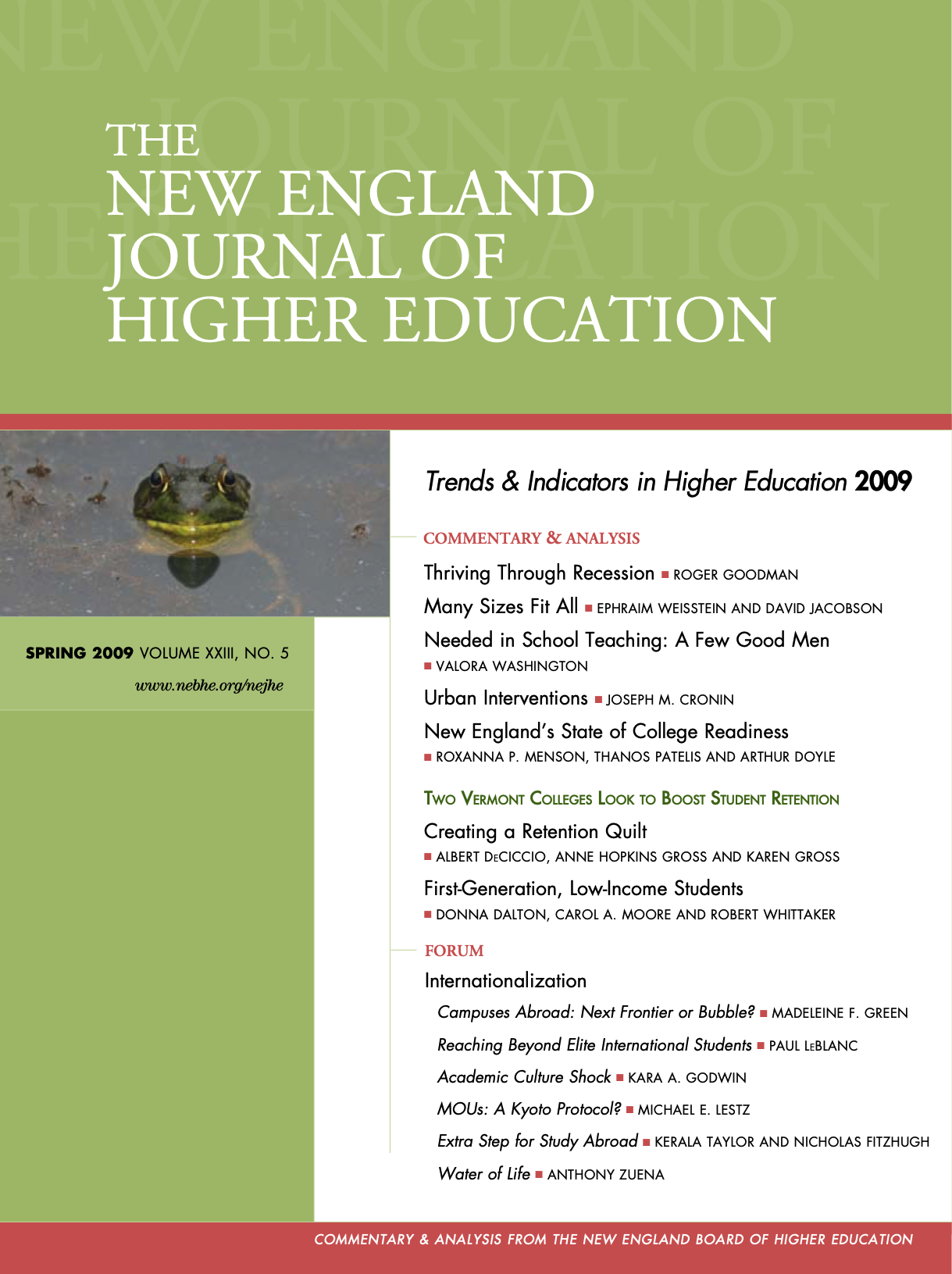
Click the cover image to view and download this issue in PDF format.
BOSTON—New England’s population continues to grow more slowly than the rest of the United States and though the region outperforms the nation on most indicators of “college readiness,” New England’s college costs still take a bigger bite out of family incomes than those in other regions, according to data in the Spring 2009 issue of The New England Journal of Higher Education (NEJHE).
The Spring 2009 issue features NEJHE’s annual special report on “Trends & Indicators in Higher Education,” which includes 60-plus updated tables and charts exploring New England’s demography, high school performance and graduation, college enrollment, college graduation rates and degree production, higher education financing and university research.
The annual trends data are complemented with a thought-provoking typology of “multiple pathways” to success and measures of college readiness from the College Board, among other features. Supplemental College Board data is available online here.
The Spring 2009 issue also features a Forum on the internationalization of higher education. NEJHE asked Forum authors to explore angles such as foreign enrollment in the United States, study abroad and critical issues in international partnerships.
Among articles in the Spring 2009 NEJHE:
Thriving Through Recession · The constant flow of alarming economic and business news, rapidly declining endowments and potential disruption to the student-loan industry have all beaten down optimism about higher education’s financial outlook. Moody’s Investors Service VP Roger Goodman explains how good financial management can help colleges and universities survive the downturn, emerge more nimble and fuel overall economic recovery.
Many Sizes Fit All · To increase the number of young people with skills to succeed in the 21st century, New England needs “multiple pathways” to high-quality postsecondary options, according to independent education consultant Ephraim Weisstein and David Jacobson, senior education specialist at Cambridge Education. The two authors of a Nellie Mae Education Foundation research paper, “Building Multiple Pathways: Approaches, Relevant Programs and Implementation Considerations,” offer a typology of pathway options.
Needed in School Teaching: A Few Good Men · The number of male teachers is at a 40-year low for reasons ranging from fear of abuse allegations to low pay. Valora Washington, president of the CAYL Institute, explains how her Cambridge, Mass.-based outfit aims to close the gender gap in teaching.
Urban Interventions · Joseph Cronin, the former Massachusetts secretary of education and past president of Bentley University, who is the author of the book Reforming Boston Schools: Overcoming Corruption and Racial Segregation 1930-2006, explains how universities have contributed thousands of hours trying to help city schools to improve and asks, “With what effect?”
New England’s State of College Readiness · Roxanna P. Menson, Thanos Patelis and Arthur Doyle of the College Board paint a picture of college readiness in New England by assembling the national organization’s indicators of academic knowledge and skills, success in college-level courses, SAT performance and college and career planning.
Creating a Retention Quilt · Southern Vermont College President Karen Gross and her colleagues Albert DeCiccio and Anne Hopkins Gross explain how the Bennington, Vt., college uses tools ranging from discussion of Robert Frost to fireside chats to create a learning community and boost retention.
First Generation, Low-Income Students · Lyndon State College President Carol A. Moore and colleagues Donna Dalton and Robert Whittaker advance strategies to bolster the first- to second-year retention rate of first-generation, low-income students.
The Spring 2009 Forum on internationalization includes the following articles:
Campuses Abroad: Next Frontier or Bubble? · Madeleine F. Green, vice president for international initiatives at the American Council on Education, weighs recruiting foreign students to home campuses in the United States vs. setting up off-shore operations. Among Green’s questions: “Do campuses abroad represent a form of cultural imperialism? … Do they contribute to the internationalization of the home campus?”
Reaching Beyond Elite International Students · Paul LeBlanc, president of Southern New Hampshire University, describes how the university is trying to reach those in the teeming middle rung of the international student population to help them compete for good-paying jobs and enjoy greater social and professional standing in their countries.
Academic Culture Shock · Kara A. Godwin, a doctoral student at the Boston College Center for International Higher Education, warns that while international students and scholars face day-to-day cultural adjustments, the stark differences they encounter in the classroom and academic system are of more concern.
MOUs: A Kyoto Protocol? · Michael E. Lestz, director of the O’Neill Asia Cum Laude Endowment at Trinity College, holds out Japan’s Kyoto University as a model for forging international partnerships.
Water of Life · Anthony Zuena, president of S E A Consultants Inc., an engineering and architecture firm headquartered in Cambridge, Mass., explores how the nonprofit organization Engineers Without Borders has dispatched engineering students and faculty to developing countries such as Honduras to help build water-distribution systems.
Extra Step for Study Abroad · Kerala Taylor and Nicholas Fitzhugh of Glimpse.org explain how students serving as overseas correspondents to the user-generated website “have done everything from exploring gay nightlife in Jordan to visiting a prosthetic foot factory in India to voyaging with Maori fishermen in New Zealand.”
New England 2025 · NEBHE President and CEO Michael K. Thomas calls on the six New England states to be more innovative, efficient and productive in order to meet an anticipated need for 665,000 additional college degrees by 2025, though the region will produce 20,000 fewer high school graduates during the same period due to demographic shifts.
The Community’s Colleges · Interest in relatively lower-cost state colleges and universities, and especially in community colleges, is surging as a result of the economic downturn, writes NEBHE Chair and Massachusetts state Sen. Joan Menard. In her Message From the Chair, Menard celebrates the multiple valuable roles of New England community colleges.
Spring in Our Step · In his quarterly Editor’s Memo, NEJHE executive editor John O. Harney discusses the journal’s annual special report on “Trends and Indicators” and the issue’s Forum on internationalization.
[ssba]
